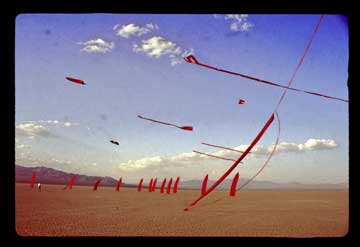
In 1970’s More Sky, Otto Piene said the following about kites; “In order to reorient artists’ concern and to reestablish touch with and influence on life, we raise our eyes and look at the world beyond the limits of ‘art’, and we study subject matter that is not in the files of art history.” Piene, with his sky balloons, wind socks, and aerial sculptures, might have been the catalyst for serious artists to consider the sky as canvas: Tal Streeter, Istvan Bodoczky, Jackie Matisse, Tsutomu Hiroi, and Curt Asker were pioneers of the movement. The art kite movement was pushed forward by 1990’s Kunstdrachen exhibit of the Goethe Institute in which world-class artists and Japanese kite artists collaborated on over 100 spectacular kites.
Today, many Western kite makers are turning to traditional materials and traditional artistic techniques to make unique and exciting art kites. Kite artist Claudio Capelli of Italy has promoted art kites in the annual Cervia Volante festival every spring. Here, the public is treated to large, show-stopping kites from all over Europe, but the attentive will also see small, graceful, and unexpected flying sculptures by many of the leading European art kite makers.
In Japan, young people with art degrees are turning to the traditional crafts like paper making – critical for kite makers to ensure their longevity. Contemporary kite makers can choose traditional kite forms and materials or use today’s technology to invent new, original forms; kites that would have been impossible to make with traditional materials. Whether inventing new and original kite forms, or pursuing original artistic approaches, kite artists are finding new and larger audiences for their work.

